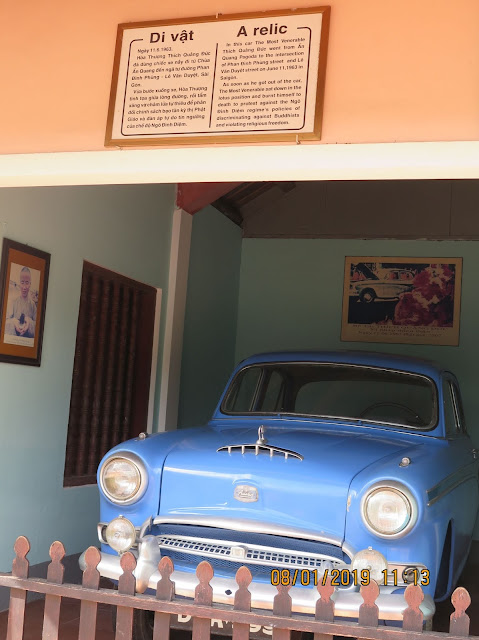Thien Mu Pagoda
Our first stop was at the Perfume River jetty where we boarded a dragon boat for a river cruise upstream to the Chua Thien Mu. By now, we had understood that Chua was the Vietnamese word for Pagoda. |
| All 32 of us could fix inside one of these spacious boats. |
 |
| The symbol of the Chua Thien Mu: a seven-storey pagoda on the grounds. |
Imperial Citadel
Leaving the Thien Mu Pagoda, we visited the Imperial Citadel next. This was once the seat of power for the Nguyen kings of Vietnam, with Hue as the capital. The Imperial Citadel is a sprawling complex of buildings, monuments, gates, landscaped gardens and the odd royal tombs.
According to a description in Wikipedia, the grounds of the Imperial Citadel are protected by fortified ramparts measuring two kilometres by two kilometres, and ringed by a moat. The water in the moat is routed from the Perfume River through a series of sluice gates. Inside the citadel is the Imperial City with a perimeter wall some 2.5 kilometres in length. And within the Imperial City is the Purple Forbidden City, which was modelled after the Forbidden City in Beijing. In the past, access to the innermost enclosure was restricted to the imperial family. The Imperial Citadel was made a UNESCO heritage site in 1993.
Because its grounds are some immense, it would have been impossible for us to walk from one attraction to another. In fact, even to get into the Citadel itself, we had to commission a special white electric car to take us in, and even then, we had to walk from a point near the citadel's flag tower to the imposing citadel gate. Once inside, another set of electric buggies awaited us to bring us around.
 |
| The flag tower, which is almost impossible to miss. |
 |
| The Citadel Gate |
 |
| Once through the gate, it was feeding time for the carp |
 |
| The Citadel's electric buggies driven by charming Vietnamese woman |
 |
| Another view of the interior of the To Mieu Temple |
 |
| And this is inside the Royal Theatre. |
 |
| One more of those imposing gates and that's it: we're about to leave the Imperial Citadel. |
 |
| Boarding the white electric cars to bring us back to the parking lot outside the Citadel. |
Royal tomb of Khai Dinh
Before we left Hue, there was one last place for the old farts to visit in the afternoon: the royal tomb of Khai Dinh, one of the last emperors of Vietnam. He proved to be very unpopular, having raised taxes on his people to build his tomb which was completed by his son after his death. The tomb is located on the outskirts of Hue and would require visitors to be healthy enough to climb the steep steps to reach Khai Dinh's final resting place. The inside of the tomb features elaborate glass and porcelain shard art while the ceiling is decorated with nine dragons. Despite the fine and bright architectural design, the place is actually quite morbid. By six o'clock, it becomes completely deserted.
Dragon bridge
By nightfall, we had reached Da Nang. The trip was uneventful with the tour guide telling us of the accident that had occurred at the Hai Van Pass. The return trip did not follow the same road that we took to Hue. Instead, the driver took us through the Hai Van Tunnel which at 6.28km is the longest tunnel in south-East Asia. The tunnel reduces the distance between Da Nang and Huế by 20 km (12 mi) and saves between 30 minutes and an hour on traveling times over the old Hải Vân Pass route.
Tired though we all were, the first thing that we did on reaching Da Nang was to stop at their Dragon Bridge. We had already noticed it on the first day of our arrival in Da Nang but here was the opportunity to see the bridge up close.




















No comments:
Post a Comment